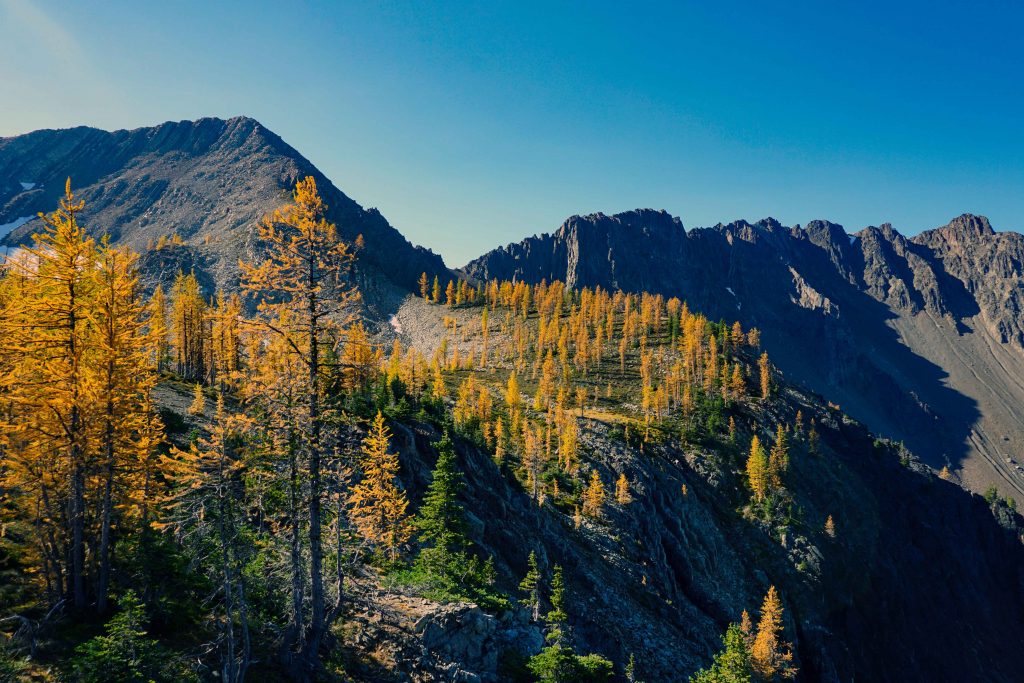See the golden larches in Manning Provincial Park by hiking the Frosty Mountain trail in late September or early October.
What are the golden larches?
As the season shifts from summer to autumn, there’s one question on every hiker’s mind: have the larches turned golden yet? If you’re wondering what all the hype is about, then let me explain.
You’ve heard of coniferous trees, right? They have needle-like leaves which stay put year-round. Then there are deciduous trees. They turn a riot of colours before shedding their leaves for the season. Well, larches are conifers – but unusually, they also lose their needles. Cool eh?
The result is that for a few precious weeks each year, larch trees around the world turn a beautiful golden colour. Arrive too early and they’ll still be green. Get there too late and the needles will already have dropped, leaving the trees bald until spring.
Just like Goldilocks and her porridge, you’ve got to get it just right.
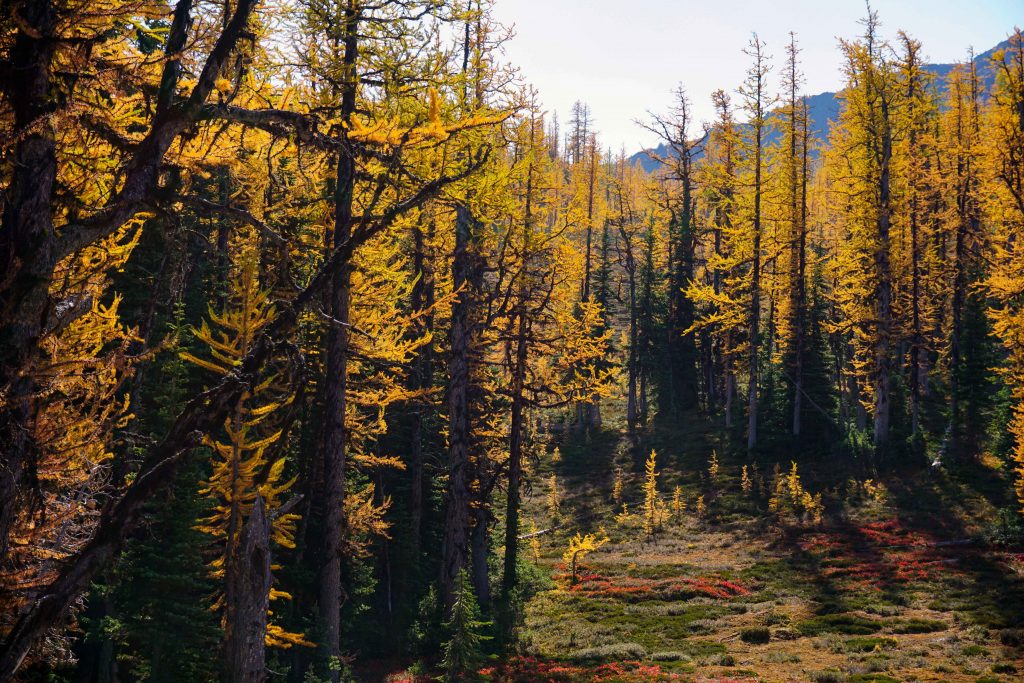
Where can you see the golden larches?
To get the real wow factor, you’re looking for the sub-alpine larch, known in Latin as the larix lyallii. These are found growing at high elevations where the temperatures are low and the soil is rocky. Stands of sub-alpine larches can be found across Canada and the USA, particularly in the Rockies and the Northern Cascades.
Popular places to see the golden larches include:
- The Sentinel Pass in Banff National Park, Alberta
- Chester Lake in Kananaskis Country, Alberta
- Cathedral Provincial Park, British Columbia
- Manning Provincial Park, British Columbia
- Maple Pass Loop, Washington State
- Cutthroat Pass, Washington State
Golden larches near Vancouver
If you live near Vancouver – and crossing the border isn’t an option (hello Covid) – then the best place to see the golden larches is in Manning Provincial Park.
But here’s the catch: these larches grow high up the side of a mountain. You can’t see them from your car, so you won’t be doing a drive-by photo shoot. Instead, you need to dust off the hiking boots and follow the trail up to Frosty Mountain.
You don’t have to reach the summit of Frosty Mountain, which stands at a considerable 2,408m. In fact, the golden larches plateau is around 2km below the peak. The hike to the plateau is certainly uphill, with approximately 800m elevation gain. But it’s manageable for the intermediate hiker, as the trail ascends gradually during a long series of switchbacks.
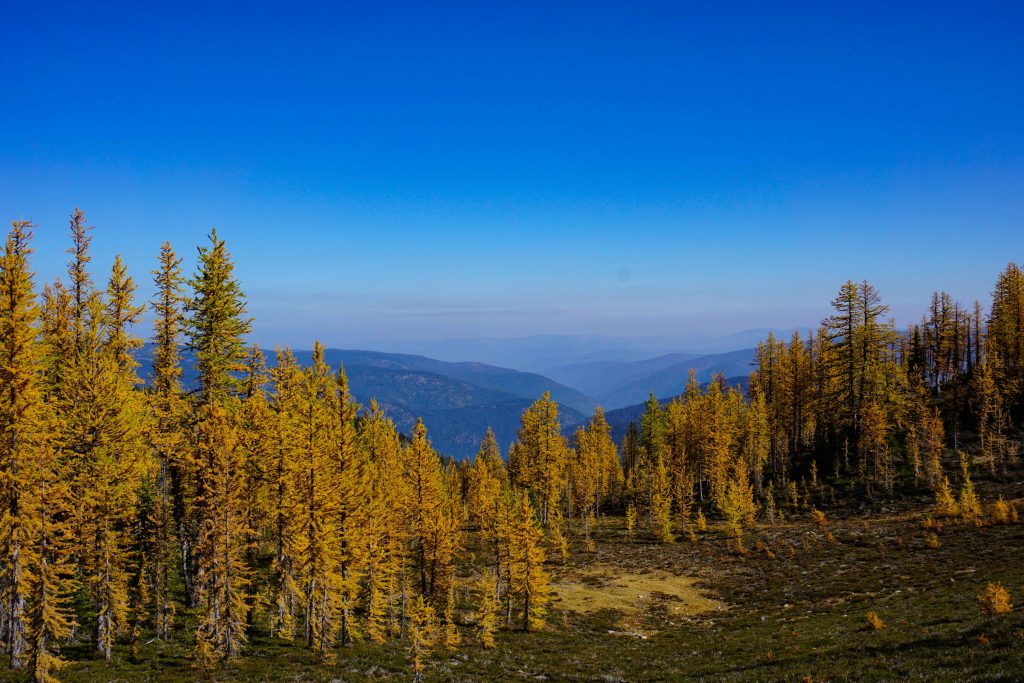
When to see the golden larches in Manning Provincial Park
The Frosty Mountain hike is typically snow-free from mid-July to early October. To catch the larches at their most vibrant, visit in late September to early October. I went in the first weekend of October and was met with a dazzling array of golden hues.
The weather in late September and early October is unpredictable. The larches are extremely high up and it’s very possible that there will be snow on the ground. Take warm layers and micro-spikes for your hiking boots. Oh, and always carry the 10 Essentials!
Top tip – these glorious larches turn golden for a short period, meaning the trail is very busy at weekends during late September/early October. If possible, time your trip for a week-day.
Frosty Mountain hike quick facts
- Distance: 22km round trip to Frosty Mountain, or 18km to the larches plateau
- Start: from the Lightening Lake day-use area in Manning Provincial Park
- Time needed: between six and nine hours, depending on your speed and whether you go all the way to the summit
- Dogs: are allowed on leash
- Elevation gain: 1,150m to the summit, 800m to the larch plateau
- Camping: is available if you want to do this as an overnight trip. Frosty Creek Wilderness Campsite is around the 7km mark.
- Alternative routes: it is also possible to reach Frosty Mountain from the Windy Joe trail. Additionally, you can do a loop trail incorporating Lightening Lake, Frosty Mountain and Windy Joe. BC Parks has more information on the options available.
- The larches in Manning Park: are, according to John Baldwin in Exploring the Coast Mountains on Skis, ‘up to 2,000 years old and are some of the oldest trees in Canada’. Woah.
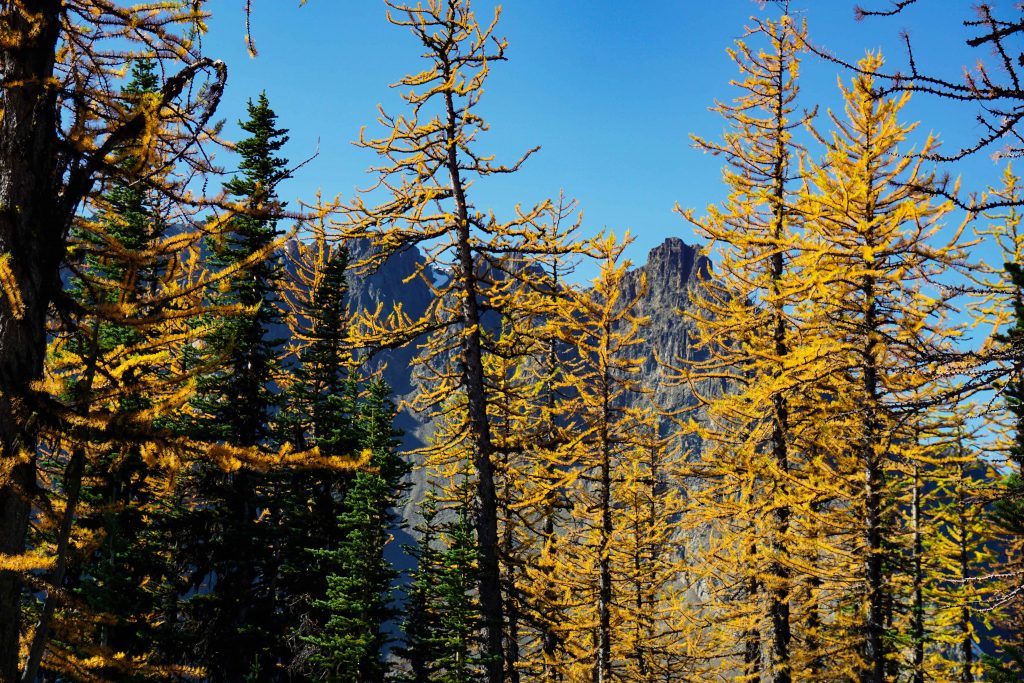
Hiking the Frosty Mountain trail
The most popular way to see the golden larches in Manning Provincial Park is to hike the Frosty Mountain Trail. This is the route I’ll describe here.
Travel directions
From Vancouver, head east-bound along Highway #1. After Hope, stay in the right-hand lane as it merges into Highway #3. Turn right immediately after Manning Park Resort onto Gibson Pass Road. There’s a signpost for Gibson Pass ski area. After you’ve made the right-hand turn, you’ll see a sign for Lightening Lake. Continue until you reach a fork in the road. Take the left-hand fork towards the Lightening Lake day-use area. Park here.
The route
Start at the Lightening Lake day-use area. If you’re looking at the lake with the parking lot behind you, head left (east) around the lake, keeping the water on your right-hand side. Cross the dam and you’ll see a trail marker for ‘Frosty Mountain trail’.
The trail immediately enters the forest. From now you can expect around 6km of switchbacks. The trail isn’t technical and ascends gradually. However, it’s very narrow which makes overtaking difficult. Bottlenecks can form on busy days, especially when there’s a two-way flow of traffic.
Every now and then the forest opens up and you’ll get a glimpse of Lightening Lake below you and Mount Hozameen in the distance. Eventually the switchbacks end and the trails levels off. You’ll undulate up and down for another 1km or so, after which you’ll reach Frosty Creek Campsite. There’s an emergency shelter, an outhouse and a very small creek.
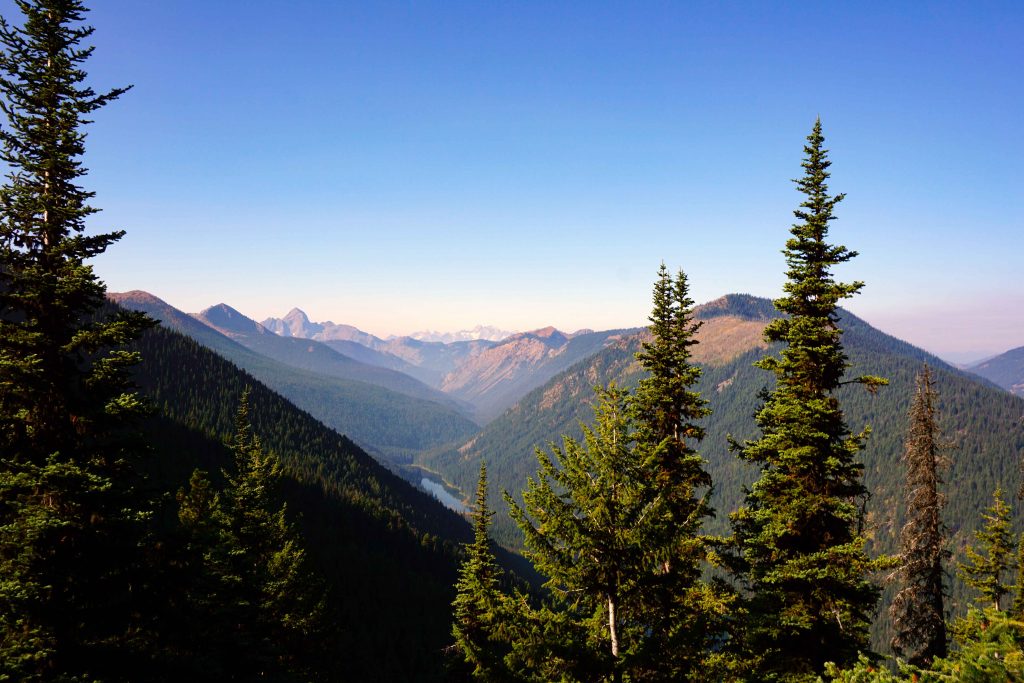
Pass through the campsite and over the creek. Now the trail begins to climb again, but it’s only 0.5km until you get to the larch grove, so keep going! Soon you reach a plaque that tells you about larch trees. Finally, you’ll get your first glimpse of the famed golden larches. Continue walking along the trail, which becomes relatively flat. You’ll find larches all around you for around 1km, set against the stunning backdrop of the Northern Cascades.
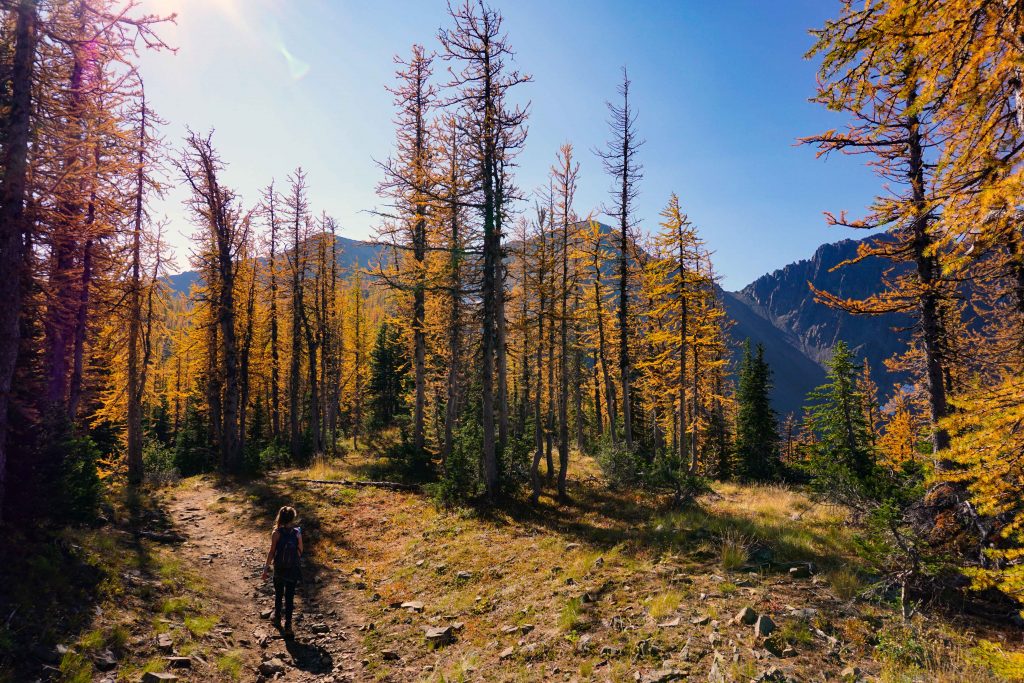
Soon the trail starts to climb once again. Then, the tree line abruptly comes to an end and you’re faced with a scree field. If you don’t want to continue to Frosty Mountain summit, this is the end of your hike. Turn around and return the way you came, taking time to appreciate the golden larches from an alternative perspective.
If you want to keep going, then be prepared for the difficulty rating to increase. Hike up through the scree field, following the pink dots painted on the stones. It’s steep and the scree is loose, so take care.

Once you’re at the ridge, turn right and walk along the ridgeline. It remains rocky and the altitude can make it hard going. Keep following the ridge until you reach the east summit.
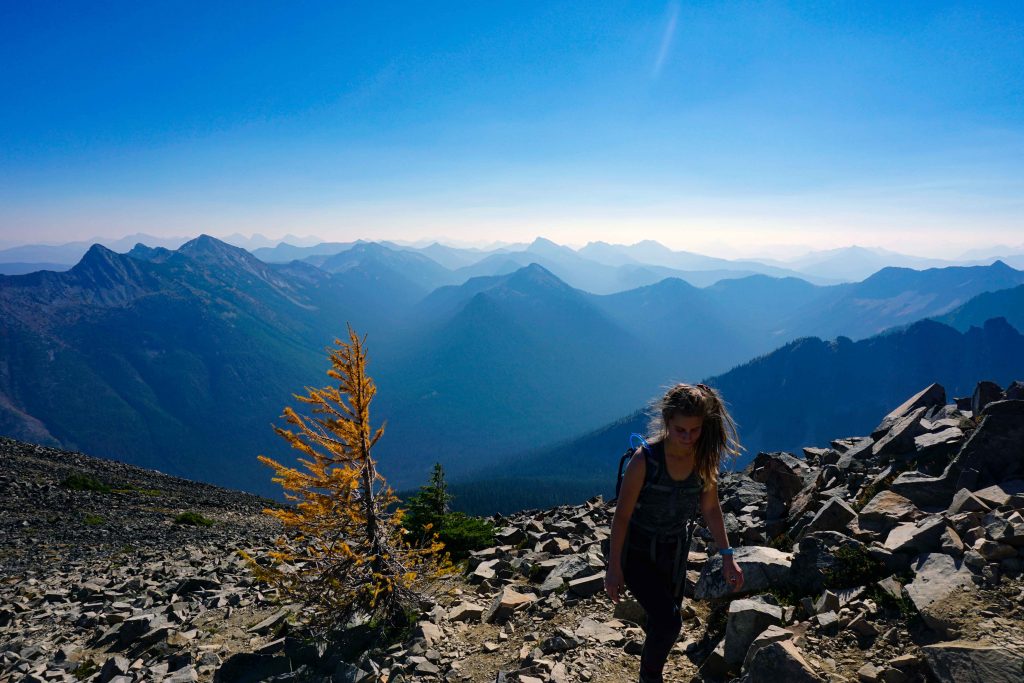
Once you arrive, you can congratulate yourself: you are standing on the highest mountain in Manning Provincial Park!
Take your time to soak up the incredible views. To the south is the Cascade Range in the USA, and to the north is a sweeping panorama of Manning Provincial Park in all its glory. Whichever way you look, there’s layer upon layer of mountains.
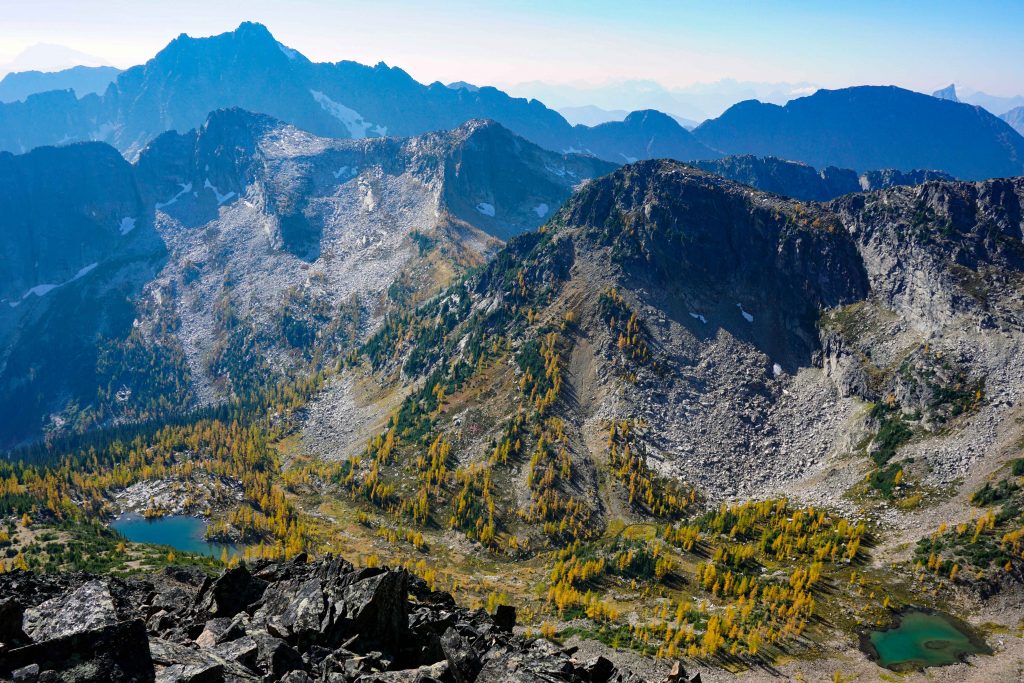
And there you have it: your complete guide to hiking the golden larches in Manning Provincial Park.
